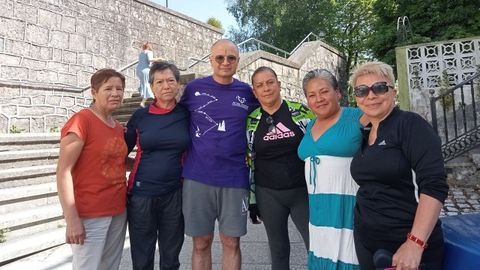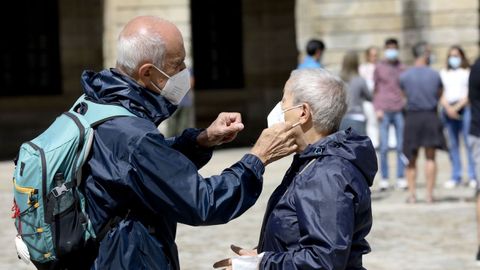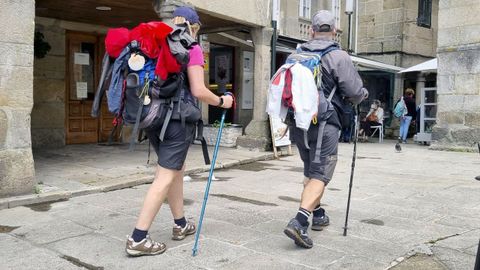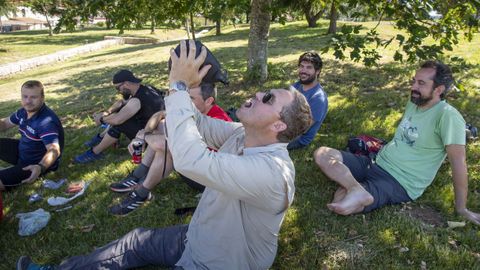The Camino de Santiago for seniors: «It's not how old you are, what matters is your physical and mental condition.»
VEN A GALICIA

Physiotherapist Vanesa López offers some tips on how best to enjoy the Jacobean routes, no matter your age.
27 jun 2022 . Actualizado a las 05:00 h.«A couple of months ago I was diagnosed with a heart problem. I was told that I needed an operation and that I had to take it easy. But here I am. I’m three stages in and I feel great,» says Isha Imelda Miranda, aged 67. She set off from Triacastela last Wednesday as part of a group of 45 pilgrims from Mexico, and while she considers herself a senior citizen, she arrived in Palas de Rei on Friday without any trouble, other than the need to take her medicine and go easy.
Like her, there are many other older pilgrims who want to make their way to Santiago de Compostela. As it happens, more than half of the pilgrims in her group «are also getting on in years», explains Ricardo, her guide on this trip. But are they an exception to the rule, or can anyone do the Camino de Santiago?
«It’s not how old you are, what matters is your physical and mental condition,» remarks physiotherapist Vanesa López Miguens, who, together with the agency SantiagoWays, offers some excellent tips and advice on how to enjoy the experience without worrying about when you were born.
Can anyone do the Camino, no matter their age?
«An active 70-year-old is more likely to succeed than a 40-year-old who sits at home all day,» explains Vanesa López. «That said, it’s reassuring to know that even if you’re not very physically active, it is always a good idea to start exercising. After all, scientific studies have shown that you’ll make huge improvements no matter your level, making it definitely worth your while, even if you start exercising at the age of 80,» she adds.

As living proof of this, we have the women accompanying Isha Imelda towards the end of the stage. Reina Cristóbal, Modesta Olivares and sisters Manuela and Diana Barrionuevo are four of the oldest pilgrims in the group, yet in the words of Diana they’ve been enjoying «the magic of the Camino» as much as anyone else. She decided to do the stage between Portomarín and Palas de Rei alone, which caused no problems whatsoever for the group, as one of the keys to having completed three stages without any injuries is that «everyone absolutely has to go at their own pace», explains Ricardo.
While age is not necessarily a determining factor, Vanesa López warns that there are certain physiological changes to bear in mind. «Exercise should be adapted to the needs of each individual and their state of health. It should also take into account factors such as the type, duration, speed, frequency and intensity of the physical activity to be performed,» she explains.
«Regardless of age, it is essential that each individual knows and listens to his or her body, heart rate and sense of fatigue in order to set realistic goals and expectations during the Camino,» she explains. She also recommends consulting a doctor if you have any existing health issues, both to find out your state of health and just in case it proves necessary to follow their instructions or even change your medication.
When it comes to physical condition, she suggests visiting a physiotherapist two to three months ahead of the trip «to be able to assess whether there could be any musculoskeletal interference and to have enough time, if necessary, to make changes or improvements in your life so that you can safely complete the Camino and enjoy yourself in the process.»

That’s exactly what Manuela Barrionuevo did, now aged 64 and having already completed two other Caminos. «I have stage four osteoarthritis and I thought about not coming, but I had some injections done to my knees and that’s then my Camino got started. I was very late in the first stage, but at least I completed it. I think about everything I was told ? that I was sick, that I wouldn’t be able to do it ? and what I thought myself ? that I didn’t feel able because of my age... yet here we are!»
Physical preparation
Proper physical preparation is essential ahead of the Camino, and this is even more important for older pilgrims. «If you’re not used to walking long distances, start with short walks, gradually building up. If possible, head out into the mountains to get used to all the ascents and descents,» says Vanesa López.
«The same goes for cycling. Start slowly, rolling at first and then alternating flat areas with climbs and switching gears as you get better,» she adds. Aside from strengthening the muscles in your legs, back and neck, the aim of these exercises is to master the distance planned for each stage.

Planning: stages, lodging and other services
Proper planning is another absolute must for the physiotherapist. «Doing the Camino from Roncesvalles (much further away from Santiago) is not the same as doing it from Tui (much closer), but broadly speaking it’s advisable for older people to walk stages of 15 or 17 kilometres or cycle 40 or 50 kilometres,» she explains. In any case, she warns that some sections and routes are more difficult than others.
There are as many opinions as there are pilgrims on what the best route is, but at SantiagoWays they offer the French Way from Sarria: «It has a long tradition, with more services along the route, and it’s also relatively flat.» The agency is often asked to personalise the experience and they might split up or shorten the stages if asked to do so by the customer. «For those worried about length, we recommend shortening the stages. For older pilgrims, it depends on their physical condition, but they often ask for shorter stages.»
As for the type of accommodation, the agency recommends hotels. «Older pilgrims usually request hotel lodging so that they can enjoy the Camino in comfort, although as always it depends on the person,» they explain. Another service they recommend for older people is rucksack transfer.

Both SantiagoWays and most of the other agencies have a 24-hour customer service. «Knowing that you have a support telephone number and an emergency vehicle is very reassuring. For people who are not used to dealing with the internet, being just a phone call away is very important,» they explain.
Recommendations during the Camino
Once the route has been planned and you’ve got enough training in, it’s time to put on your boots and set off, provided they’ve been worn in! Both Vanesa López and SantiagoWays remind all pilgrims, regardless of age, that you should never wear new shoes on the Camino. When it comes to foot care, the physiotherapist recommends cooling your feet from time to time in a fountain, «taking care to dry them well!». Indeed, this is something that Manuela used to do without having to be told, and has the photos to prove it on her mobile phone.
The back is another part of the body you need to take good care of. For those who decide to dispense with the rucksack transfer service, it’s important to make sure that your backpack is well-fitted «and follows the contours of your back, without too much slack but also not being too tight” and with the weight “close to the axis of the body and its centre of gravity,» explains Vanesa López.

The physiotherapist also recommends poles or walking sticks to help with stability and uneven footing. At SantiagoWays, they recommend «trying out different sizes of walking stick beforehand to see which one’s right for your body,» as a stick that’s cumbersome to walk with is worse than no stick at all.
Breaks are another important aspect of any stage. «We all need to rest before we get too tired if we want to recover properly; if we become exhausted, the recovery process will be much slower and can cause problems,» explains Vanesa López, who goes so far as to recommend one full day of rest a week on long journeys. «To avoid muscle fatigue, drink plenty of fluids, including an energy drink every now and then to replenish lost mineral salts,» she adds.
In fact, staying hydrated is hugely important «before, during and after walking.» Ideally, you should consume around two litres of water a day. Drinking the equivalent of a glass of water every 40 minutes, «even before you feel thirsty» is a good way to pace yourself and stay hydrated.

But if there is one thing the five Mexican pilgrims agree on, it’s that the Camino is «more mental than physical». For 62-year-old Diana, the best way to cope with fatigue is not to look ahead at the road, but to focus «on nature and the landscape.» For Modesta, 54, it’s about listening to the sound of the wind and the birds.
What to do in the event of injury
Despite best-laid plans, any pilgrim can suffer injuries. Tendinitis, sprains and traumatic arthritis are the most common afflictions. Vanesa López explains how to prevent them and what to do should they appear.
For tendinitis, better known as a pulled muscle, the expert recommends «applying localised cold to ease the inflammation and pain, remembering that if we apply ice we should never do so directly on the skin but wrap it in paper or cloth to avoid ice burns.» In pilgrims, tendinitis most commonly affects the Achilles tendon, so it’s always best to stretch before setting off and not to tighten the boots too much if the height of the boot reaches the ankle.
In the event of a sprain, «assuming there is no ligament rupture, applying ice where it hurts and getting one or two days of rest is usually enough to be able to press on», explains the expert. To help prevent this kind of injury, try to keep your rucksack as light as possible and make sure that your choice of boot includes ankle support.
Traumatic arthritis, she explains, is minor trauma to the joints (mainly the knees), limiting your mobility. As it often flares up after long descents with the rucksack weighing down on tired legs, she recommends arranging shorter stages. If injury does occur, it should be treated with cold.

In any case, if any problem or injury arises, «the best thing to do is to head to the nearest physiotherapist,» adds Vanesa. The Official College of Physiotherapists of Galicia offers a guide to physiotherapy centres along the Camino de Santiago.
The benefits of the Camino
Injuries aside (hopefully you’ll get none just ask the group of 45 pilgrims «without injuries or a single blister»), the Camino can be very beneficial for the body. Vanesa López reminds us that it is ultimately exercise, meaning that it «improves lung capacity, mobility, flexibility, agility, balance, posture, coordination, tone and muscle strength, as well as regulating blood pressure and preventing a multitude of diseases such as brittle bones and sarcopenia, which are two syndromes associated with age, predictors of disability and which entail loss of strength, endurance, muscle mass and a general decline in physiological function.»
In a nutshell, «It’s a great opportunity to release spent-up tension, disconnect from the routine, socialise, exercise and get close to nature, which brings great benefits and ensures pulmonary and mental oxygenation.»
Reina Cristóbal, her eyes full of emotion, confirms this: «It’s the first time I’ve travelled by plane and the first time I’ve been to another country. It’s all wonderful. The Camino is pure magic.»
Techniques for walking, by Vanesa López Miguens
- Before starting: stretch calves, quads and hamstrings.
- Start walking at a gentle pace until your body warms up.
- Be sure to rest every one to two hours.
- Keep up a comfortable pace: one that allows you to effortlessly chat with others as you walk, without trying to keep up with someone who walks faster than you.
- On the climbs: your step should be shorter and slower, loosening the belt of the backpack to be able to breathe better and making sure the whole sole of the foot is in contact with the ground on each step.
- On the descents: terrain permitting, take long, fast strides, digging your heels in and tightening your rucksack a little more around your waist.
- On rough terrain: we need to be more wary… every step counts!